Identifying a Wooly Malamute can be made simpler by familiarizing yourself with their defining traits. These unique dogs, also known as Wooly Alaskan Malamutes, have a longer and denser coat compared to their counterparts. It’s important to note that Wooly Malamutes are not a separate breed but rather a variation of the Alaskan Malamute.
To successfully identify a Wooly Malamute, understanding their distinctive characteristics is crucial. This comprehensive guide will provide you with valuable insights into recognizing these magnificent dogs with ease.
Throughout this article, you will learn about the specific traits that make Wooly Malamutes stand out, including their distinctive coat and physical attributes. Additionally, you’ll discover how to identify Wooly Malamute puppies and the importance of regular grooming.
By the end of this guide, you’ll have a comprehensive understanding of what it takes to identify a Wooly Malamute accurately. Let’s dive in and explore the fascinating world of these beautiful dogs.
What is a Wooly Malamute?
A Wooly Malamute is not a separate breed but rather an Alaskan Malamute with a longer and denser coat. These dogs have a majestic appearance with their thick fur, making them easily recognizable among other Alaskan Malamutes. The longer coat of a Wooly Malamute sets them apart and gives them a distinct look.
One of the key distinguishing features of a Wooly Malamute is their plush double coat, which consists of a soft undercoat and a longer, coarser outer coat. This dense coat provides them with excellent insulation, protecting them from harsh weather conditions. Their fur is especially important for surviving in colder climates.
Quote: “The long and dense coat of a Wooly Malamute requires regular grooming to prevent matting and maintain its health.”
Recognizing a Wooly Malamute becomes easier as they grow older. Their coat develops and becomes more prominent, making them stand out in a crowd. However, it’s important to note that identifying a Wooly Malamute in puppies can be more challenging. Look for signs such as longer fur behind the ears and a thicker coat compared to other puppies in the litter.
| Key Traits of a Wooly Malamute: | Notable Characteristics: |
|---|---|
| Long and dense fur | Excellent insulation |
| Fluffy tail | Distinctive appearance |
| Pronounced mane and ruff | Majestic look |
| Reduced shedding | Less hair around the house |
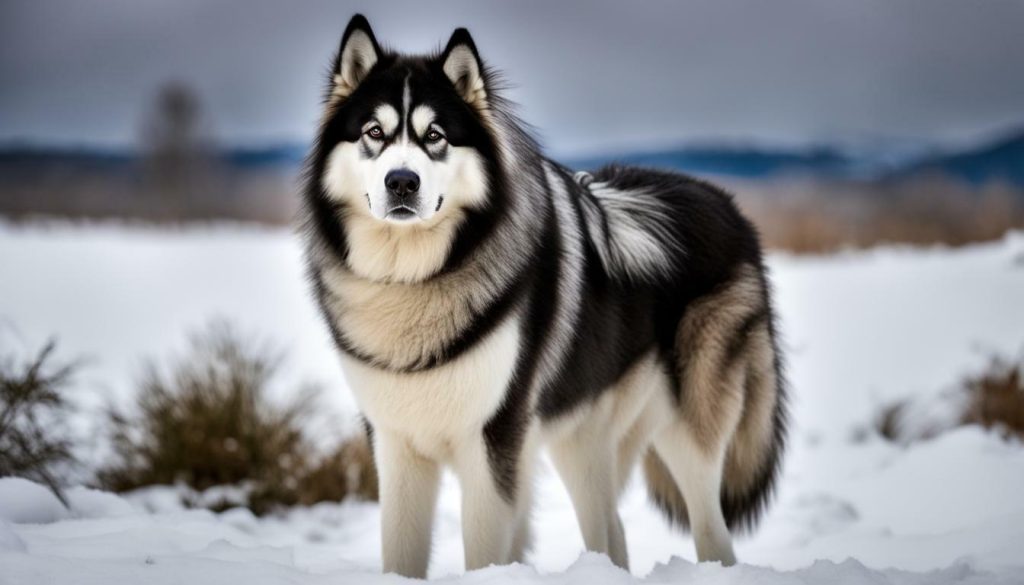
Grooming a Wooly Malamute requires regular care to maintain their coat’s health. Due to their longer fur, they are more prone to matting, tangling, and debris accumulation. It’s essential to brush them thoroughly, removing any loose hair and preventing mats from forming.
By familiarizing yourself with the distinguishing features of a Wooly Malamute, you’ll be able to recognize these beautiful dogs and appreciate their unique qualities. Remember that actively breeding for Wooly Malamutes is not recommended, as it can lead to health issues associated with their specific coat type. Enjoy the beauty and charm of Wooly Malamutes while understanding the importance of responsible breeding and grooming practices.
Identifying Wooly Malamutes
Identifying a Wooly Malamute can become easier with experience, but there are some key features to observe. Wooly Malamutes are not a separate breed but rather a variety within the Alaskan Malamute breed. Their distinguishing characteristic is their longer and denser coat, which sets them apart from other Alaskan Malamutes.
When spotting a Wooly Malamute, look for their strikingly beautiful fur, which can reach great lengths, especially around the neck and tail. Their fur is thick and fluffy, providing excellent protection against the cold weather. Additionally, their coat may come in various colors, including shades of gray, black, and white.
“Wooly Malamutes have a luxurious coat that requires regular grooming to keep it in good condition. Their long fur may shed heavily during shedding seasons, so it’s important to be prepared for regular brushing sessions.”
It’s important to note that identifying a Wooly Malamute as a puppy can be more challenging. However, some signs to look for include longer fur behind the ears and reduced shedding in comparison to other Malamute puppies. As they grow older, their coat will become more apparent and easier to identify. It’s worth mentioning that not all Alaskan Malamute puppies with long fur will develop into Wooly Malamutes, as coat development can vary within the breed.
| Key Features | Characteristics |
|---|---|
| Fur Type | Long and dense |
| Coat Colors | Gray, black, white, and various combinations |
| Grooming Needs | Regular brushing to prevent matting and maintain coat health |
To keep a Wooly Malamute’s coat in good condition, regular grooming is essential. Brushing their fur at least once a week helps prevent matting and tangling, while also reducing shedding. This not only keeps their coat healthy but also strengthens the bond between you and your furry companion.
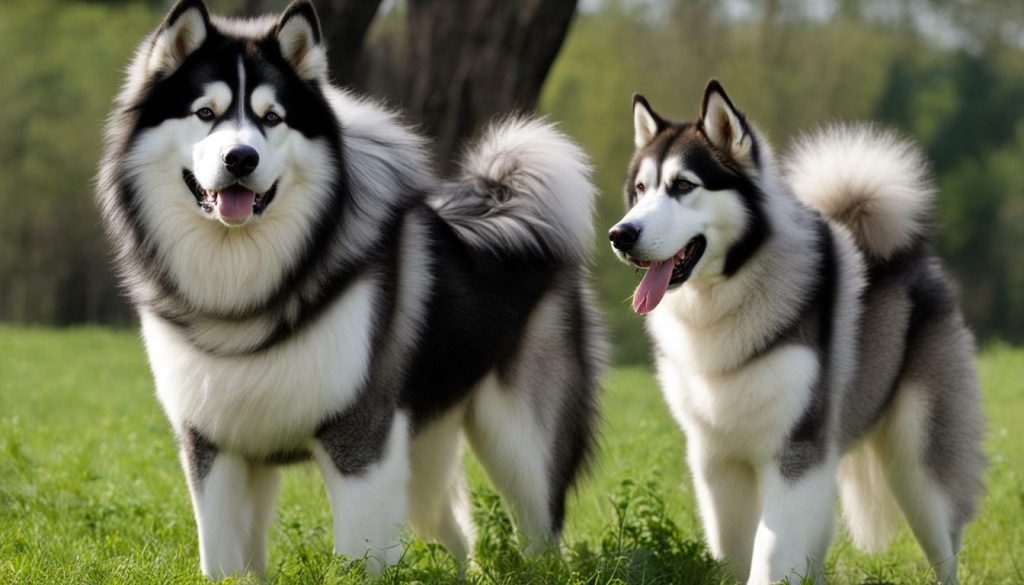
Identifying a Wooly Malamute requires paying attention to their unique coat characteristics. Their long and dense fur, along with various coat color combinations, make them easily distinguishable. While identifying them as puppies may be more challenging, observing features such as longer fur behind the ears and reduced shedding can provide clues. Remember, regular brushing is crucial for keeping their coat healthy and preventing matting. By understanding these key features, you’ll be better equipped to identify and care for a Wooly Malamute.
Identifying Wooly Malamute Puppies
Identifying a Wooly Malamute puppy requires paying attention to certain physical characteristics. While all Alaskan Malamute puppies have fluffy coats, Wooly Malamute puppies have longer fur that continues to grow as they mature. This is one of the key features that distinguish them from their shorter-coated counterparts. Additionally, Wooly Malamute puppies often have an abundance of fur behind their ears, giving them a distinctive, shaggy appearance.
Another noticeable trait in Wooly Malamute puppies is their reduced shedding compared to other Alaskan Malamutes. While all Malamutes shed, Wooly Malamutes shed less due to their longer and denser fur. This characteristic can be helpful when trying to identify a Wooly Malamute puppy.
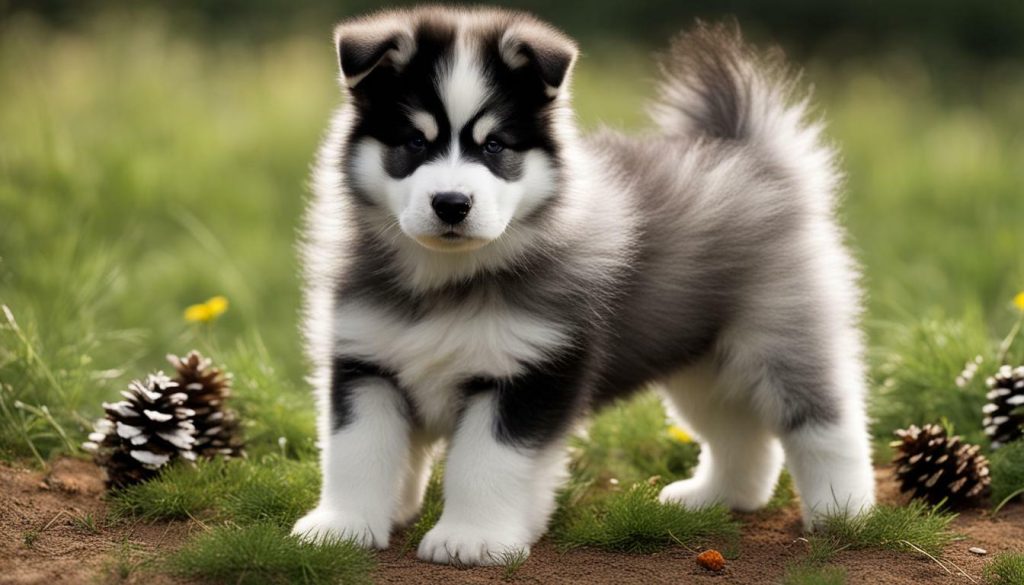
Table: Key Physical Characteristics of Wooly Malamute Puppies
| Physical Characteristic | Description |
|---|---|
| Long Fur | Wooly Malamute puppies have longer fur that continues to grow as they mature. |
| Fur Behind Ears | Wooly Malamute puppies often have an abundance of fur behind their ears, giving them a shaggy appearance. |
| Reduced Shedding | Compared to other Malamutes, Wooly Malamute puppies shed less due to their longer and denser fur. |
It’s important to note that as Wooly Malamute puppies grow into adulthood, their long and dense coats become more pronounced. By closely observing these key physical characteristics, you can confidently identify a Wooly Malamute puppy and appreciate their unique beauty.
Signs of a Wooly Malamute in Puppies
While it may be more challenging to identify a Wooly Malamute in puppies, there are some early signs to watch out for. These signs can help you determine if a puppy is likely to develop the longer and denser coat characteristic of a Wooly Malamute as they grow older. Here are some key indicators to look for when identifying a Wooly Malamute puppy:
“Wooly Malamute puppies often have long fur behind their ears, which is a precursor to the longer and denser coat they will have as adults. This early sign can be a strong indication that the puppy will develop into a Wooly Malamute.”
Additionally, Wooly Malamute puppies may exhibit reduced shedding compared to other Alaskan Malamutes. This means that you may notice less fur around your home when raising a Wooly Malamute puppy. Although shedding patterns can vary, this characteristic can be a helpful clue in identifying a potential Wooly Malamute.
It’s important to note that while these signs may be present in some Wooly Malamute puppies, they are not definitive proof. The length and density of a puppy’s coat can change as they grow, and it may take time to accurately determine if they will develop into a Wooly Malamute. Consulting with a reputable breeder or an experienced Alaskan Malamute enthusiast can provide further guidance in identifying and understanding Wooly Malamute puppies.
Remember, identifying Wooly Malamutes in puppies requires careful observation and a thorough understanding of the breed’s characteristics. By being attentive to these early signs and seeking expert advice when needed, you can gain valuable insights into whether a puppy is likely to become a stunning Wooly Malamute.
Table 1: Signs of a Wooly Malamute in Puppies
| Signs | Description |
|---|---|
| Long fur behind ears | Puppies may have longer fur behind their ears, indicating the potential development of a longer and denser coat. |
| Reduced shedding | Wooly Malamute puppies may exhibit less shedding compared to other Alaskan Malamutes. |
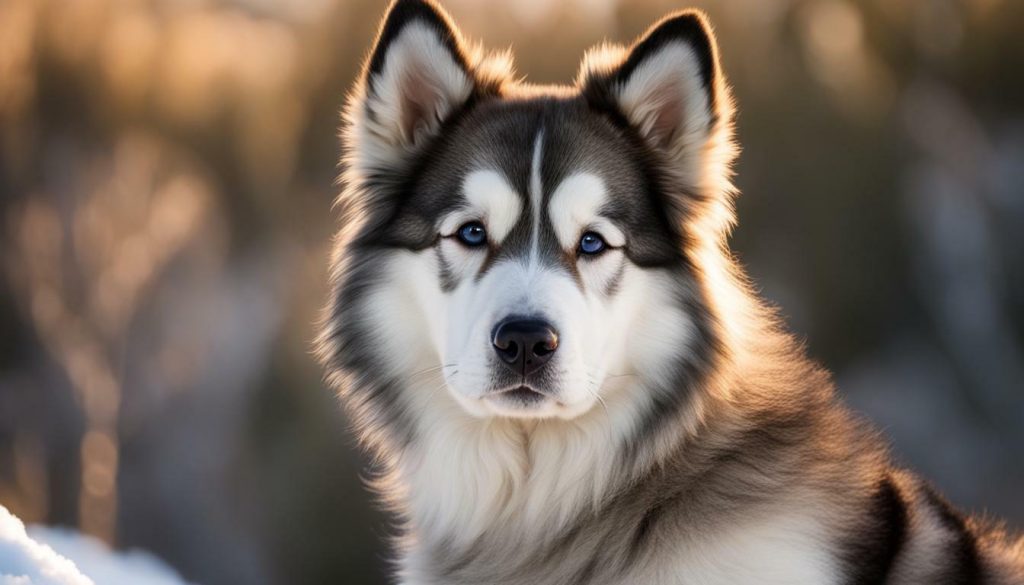
Grooming plays a crucial role in keeping a Wooly Malamute’s coat in optimal condition. These magnificent dogs have a longer and denser coat compared to their Alaskan Malamute counterparts, requiring extra attention and care. Regular brushing is essential to prevent matting, tangles, and maintain their coat’s health.
To effectively groom a Wooly Malamute, start by using a slicker brush or a wide-toothed comb to carefully remove any knots or tangles. Focus on areas prone to matting, such as behind the ears, under the belly, and around the tail. Be gentle and patient to avoid causing any discomfort or pain.
“Regular brushing not only keeps their coat looking beautiful, but it also helps to distribute natural oils and stimulate blood flow to their skin,” says expert groomer, Lisa Anderson.
In addition to brushing, regular bathing is necessary to maintain cleanliness and remove dirt and debris from their thick fur. Use a mild dog shampoo and conditioner specifically designed for long-haired breeds, and make sure to rinse thoroughly to prevent any product residue.
| Grooming Tips for Wooly Malamutes: | |
|---|---|
| Brush their coat at least two to three times a week to prevent matting. | 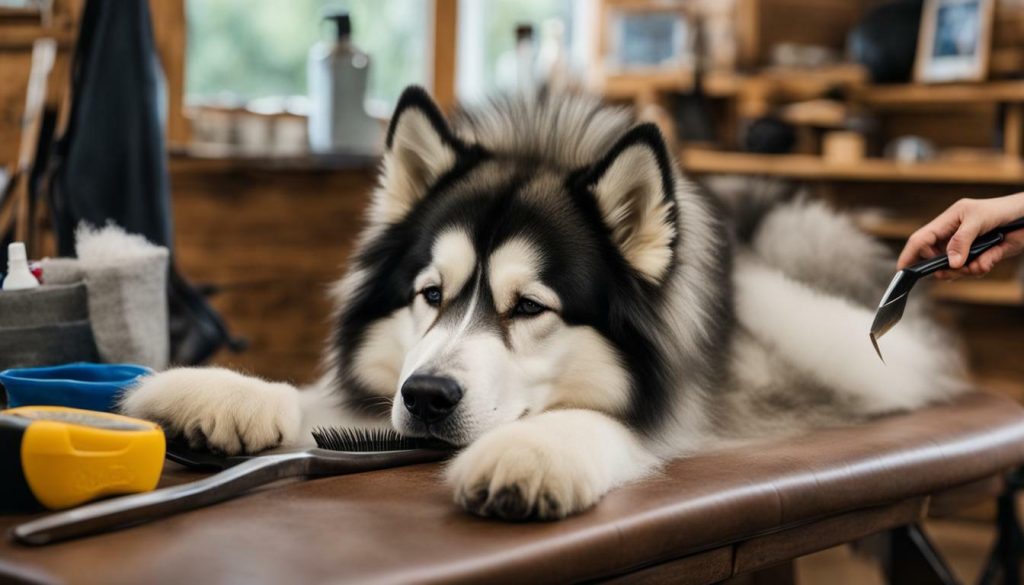 |
| Trim their nails regularly to avoid discomfort and potential injury. | |
| Check their ears weekly and clean them gently to prevent infections. | |
| Avoid shaving their coat as it provides insulation and protection from the elements. |
Remember to give your Wooly Malamute plenty of praise and treats during grooming sessions to create a positive experience. If you find grooming challenging or overwhelming, consider seeking professional grooming services to ensure your furry friend receives the care they need.
The Importance of Regular Brushing
Regular brushing is vital for a Wooly Malamute’s coat health and overall well-being. With their long and dense fur, these majestic dogs require dedicated grooming to keep their coats in top condition. By establishing a consistent brushing routine, you can prevent matting, reduce shedding, and maintain the natural beauty of their fur.
When brushing a Wooly Malamute, it is important to use the right tools. A slicker brush or a wide-toothed comb is recommended to effectively remove loose hair, tangles, and debris. Begin by gently brushing the fur in the direction of hair growth, taking care to reach the undercoat. This will help distribute the natural oils and ensure a healthy, shiny coat.
During the grooming process, pay attention to sensitive areas such as the ears, tail, and paws. These areas may require extra care to avoid discomfort or injury. Regular brushing also provides an opportunity to inspect your Wooly Malamute’s skin for any signs of irritation, ticks, or fleas. If you notice any abnormalities, it is important to consult a veterinarian for appropriate treatment.
Remember to approach grooming as a positive and bonding experience with your Wooly Malamute. Offer praise and rewards throughout the process to keep them relaxed and cooperative. By incorporating regular brushing into your routine, you are not only promoting good coat health but also supporting your dog’s overall well-being.
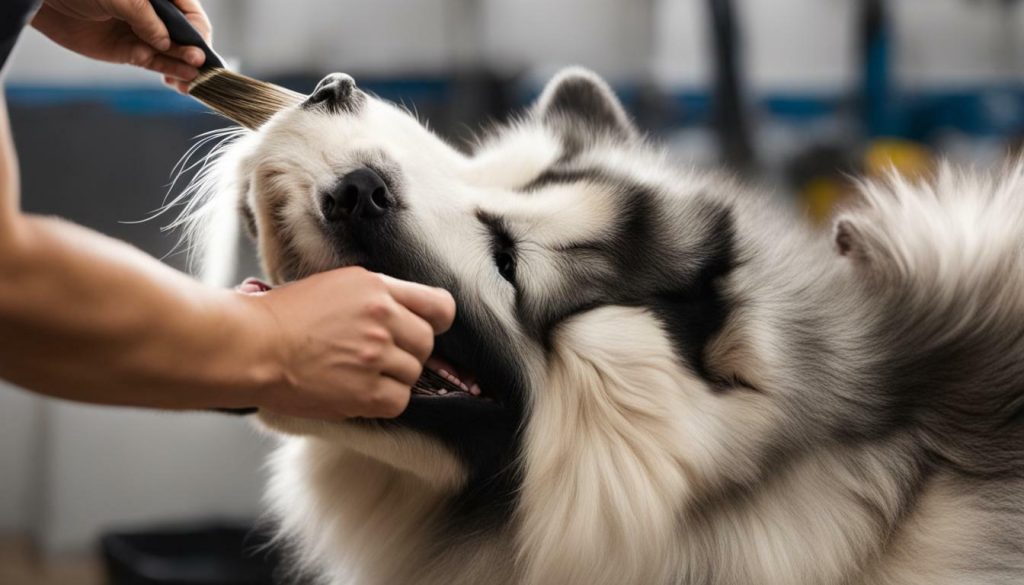
Actively breeding for Wooly Malamutes is generally discouraged due to potential health concerns. While these dogs may have a stunning and distinctive appearance with their long, dense coats, it’s important to prioritize their overall well-being.
Wooly Malamutes are not a separate breed but rather a variety within the Alaskan Malamute breed. Their longer fur is the result of a genetic variation called the “wooly gene.” However, breeding specifically for this coat type can lead to a range of concerns.
One of the main issues associated with breeding for Wooly Malamutes is the increased risk of heat-related problems. The thicker coat can make it more challenging for these dogs to regulate their body temperature in hot climates or during exercise. They are more prone to overheating, which can be dangerous and even fatal if not managed properly.
Additionally, the dense coat requires extensive grooming and maintenance. Regular brushing is essential to prevent matting, which can cause discomfort and skin irritations. Breeding for Wooly Malamutes may contribute to an overpopulation of dogs with high grooming needs, placing a burden on owners and potential adopters.
It’s crucial to prioritize the health and well-being of the breed when considering breeding practices. Instead of focusing solely on appearance, breeders should prioritize the overall health and temperament of the dogs. Responsible breeding practices aim to improve the breed as a whole and prevent potential health issues.
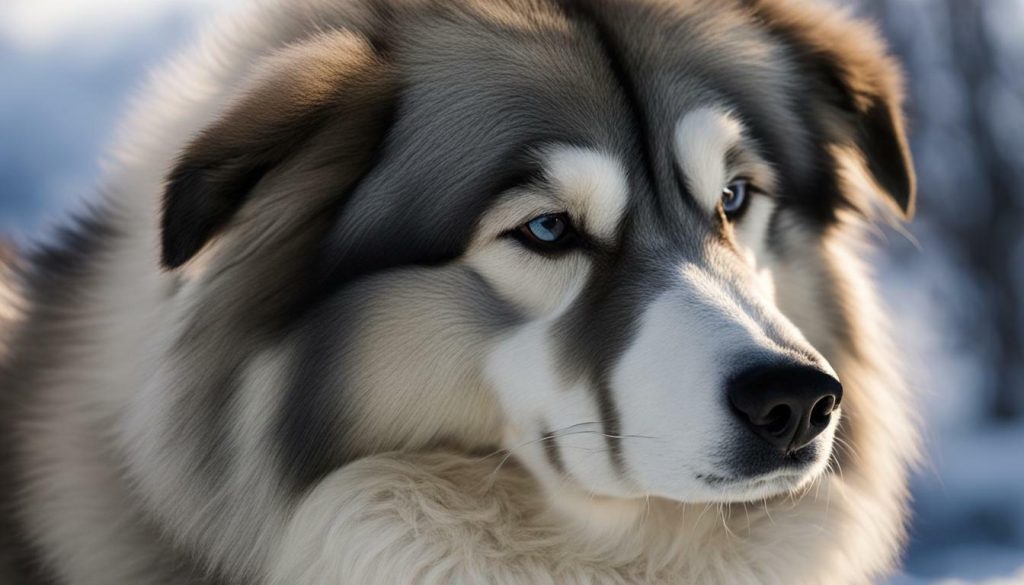
Grooming a Wooly Malamute requires regular maintenance to keep their coat healthy and free from matting. Here are a few essential tips:
| Grooming Step | Frequency |
|---|---|
| Brushing | At least once a week |
| Bathing | Every 2-3 months or as needed |
| Nail trimming | Every 4-6 weeks |
| Ear cleaning | Once a month |
Regular grooming not only keeps your Wooly Malamute’s coat looking its best but also helps maintain their overall health and well-being.
When brushing, use a slicker brush or a comb with medium to long teeth to prevent tangles and remove loose hair. Pay extra attention to the undercoat and areas prone to matting, such as behind the ears and around the tail. If your Malamute gets dirty, a gentle bath using dog-specific shampoo will help keep their coat clean.
Remember, grooming sessions are also an excellent opportunity to bond with your dog and check for any signs of skin issues or parasites. If you’re unsure about proper grooming techniques or encounter any concerns, consult a professional groomer or your veterinarian for guidance.
By prioritizing the well-being of Wooly Malamutes and following proper grooming practices, you can ensure that these majestic dogs thrive and continue to bring joy to their owners.
Conclusion: Identifying a Wooly Malamute Made Simple
By familiarizing yourself with the characteristics and traits of a Wooly Malamute, you can confidently identify these unique dogs. A Wooly Malamute is not a separate breed but rather an Alaskan Malamute with a longer and denser coat. Understanding what sets them apart is the first step in recognizing them.
When it comes to identifying Wooly Malamutes, age can play a role. As these dogs mature, their signature long and fluffy fur becomes more prominent, making them easier to spot. However, even as puppies, there are certain signs to look for. Pay attention to the length of fur behind their ears and observe if they display reduced shedding, as these are common traits of a Wooly Malamute.
Grooming plays a vital role in maintaining the health and appearance of a Wooly Malamute’s coat. Regular brushing is essential to prevent matting and keep their fur free from tangles. By establishing a grooming routine, you can ensure the well-being of their long and dense hair, as well as reduce shedding.
It’s important to note that actively breeding for Wooly Malamutes is not recommended. While these dogs are undeniably beautiful, focusing solely on their coat type can lead to health issues. Responsible breeding practices should prioritize the overall well-being of the dogs and aim for a balanced and healthy lineage.
In conclusion, understanding how to identify a Wooly Malamute involves recognizing their distinct characteristics, such as their longer and denser coat. By observing these traits, properly grooming their fur, and keeping in mind the importance of responsible breeding, you can confidently identify and appreciate these unique dogs.
FAQ
Q: What is a Wooly Malamute?
A: A Wooly Malamute is an Alaskan Malamute with a longer and denser coat. They are not a separate breed but have distinct characteristics that set them apart.
Q: How can I identify a Wooly Malamute?
A: Identifying a Wooly Malamute can be easier as they get older. Some signs to look for in puppies include long fur behind the ears and reduced shedding. Additionally, their longer and denser coats are usually a giveaway.
Q: What are the grooming requirements for a Wooly Malamute?
A: Grooming a Wooly Malamute requires regular brushing to prevent matting and maintain the health of their coat. Their long and dense fur requires extra attention to avoid tangling and keep them looking their best.
Q: Is breeding for Wooly Malamutes recommended?
A: Actively breeding for Wooly Malamutes is not recommended. Focusing solely on the coat type can lead to health issues and neglecting other important aspects of the breed’s well-being.
